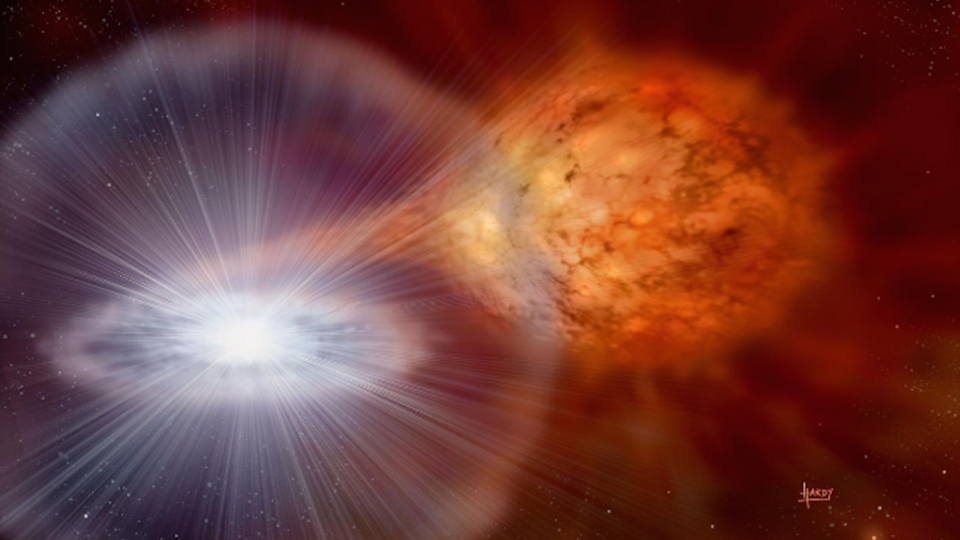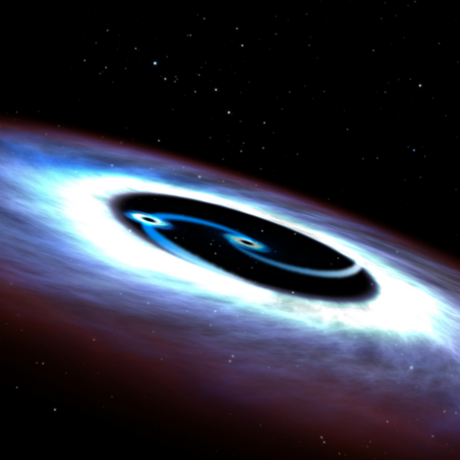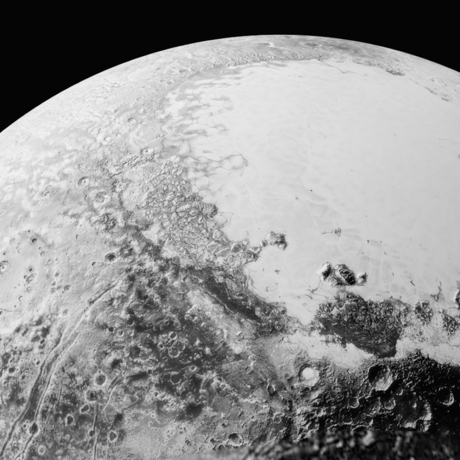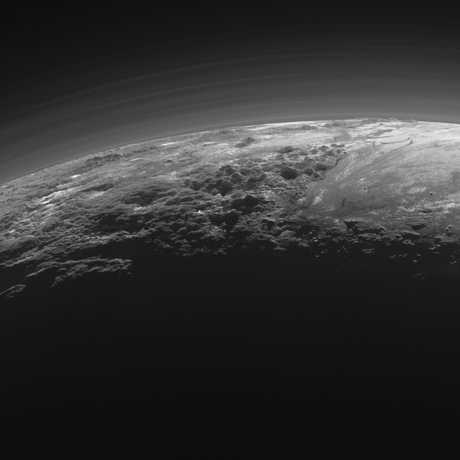Science News
A Chameleon Planet, Last of Pluto Data, and Lithium’s Source

A Color-Changing Planet
“A leopard can't change its spots.” Or so the saying goes. Actually it can, and so can someplanets! But what about a zebra—or a planet—changing its stripes? Well, every now and then, Jupiter loses a stripe…
Studying changes on theses gaseous worlds can help scientists better understand their atmospheres. Now, they’ve watched as yet another world partly changed its color, like a giant space-chameleon.
NASA’s Cassini spacecraft has been orbiting the giant planet Saturn for the past dozen years, and Cassini’s images reveal that, over the past four years, Saturn’s north polar region has turned from a cold, bluish-gray to a rich, golden yellow. The color change is occurring inside the curious north polar hexagon—a colossal atmospheric feature measuring roughly 32,000 kilometers (20,000 miles) across.
(The hexagon was discovered in 1988 from data recorded earlier during the Voyager flybys in 1980 and 1981. It is thought to be an arctic jet-stream molded into a naturally stable, six-sided shape by perturbations in its path and by winds at lower depths in the atmosphere. It has been duplicated in computer simulations and fluid models.)
Planetary scientists think the color-changes have to do with Saturn’s seasons. Just as Earth’s 23.5° axial tilt results in our seasonal cycle, Saturn’s similar 26.7° tilt does likewise. When Cassini arrived at Saturn in 2004, the north pole was just emerging from winter darkness, during which the hexagonal jet stream acts as a protective barrier, holding off any aerosol particles traveling up from the south and allowing the atmosphere to clear up, and turning blue.
As northern summer approaches (due to arrive in May 2017), more sunlight gradually encroaches across the hexagon. Chemical reactions between sunlight and the gases in the atmosphere produce aerosols and haze, causing the change in color from blue to gold. (Go Bears!)
Cassini has been orbiting the Ringed Planet for half a Saturnian year, and that's all it’s going to get, as the mission is slated to end in September 2017 due to a lack of maneuvering propellant. Without that fuel, the spacecraft could conceivably spin out of control and crash into one of the giant planet’s potentially life-friendly moons, Enceladus or Titan, and scientists would like to avoid even the slightest chance of contamination by microbes that may have hitched a ride from Earth. Therefore, mission operators have decided to put the spacecraft into a polar orbit in April, looping 22 times between the planet and its rings, and finally diving into the atmosphere and burning up… if it survives its daring series of plunges inside the rings. –Bing Quock
So Long and Thanks for all the Bits
After zooming past Pluto in July 2015, NASA’s New Horizons mission has transmitted its last bits of information about the dwarf planet. What has it been up to for over a year? Sending data! All in all, about 50 billion bits. Sounds impressive, doesn’t it? Well, that comes out to just about 6.25 gigabytes in total. A modern smartphone holds much more information. Want another Earthly perspective? Here on Earth, even a slow Internet connection, would send this amount information over a couple of hours. So why have we been waiting almost 500 days?
It turns out that sending information from billions of miles away is no easy feat. Signals have to cross light hours of space to reach our massive Deep Space Network (DSN) dishes here on Earth. Since the DSN is responsible for communicating with the majority of our neighboring world missions, time on the array is a precious commodity. Since New Horizons is broadcasting with a modest pair of 12-watt transmitters, we end up with a frustrating 1,200 bits per second, something to be expected from a modem used three decades ago.
Have we heard the last of New Horizons? Assuredly no. She is still outbound, heading toward a Kuiper belt object dubbed 2014 MU69—a 30-50 kilometer (20-30 mile) blob of ancient reddish rock leftover from the earliest ages of our solar system. Flying within 2,000 miles of it will give us our best view yet of this ancient object. So stay tuned for more from New Horizons—it just might take awhile—the encounter is scheduled for January 1, 2019. –Josh Roberts
Lithium Formation in Novas
Carl Sagan famously said “the nitrogen in our DNA, the calcium in our teeth, the iron in our blood, the carbon in our apple pies were made in the interiors of collapsing stars. We are made of starstuff.” And it’s not just what we find in us humans—every element has an astronomical origin. Between ten seconds and twenty minutes after the Big Bang, the first and lightest elements formed in primordial nucleosynthesis—about 75 percent hydrogen, 25 percent helium, and trace amounts of lithium and beryllium. Two hundred million years later, when the first stars began to shine, fusion in their cores transformed hydrogen into helium and forged increasingly heavier elements through iron (with heavier elements produced in nova and supernova explosions)—a process that still continues in stars throughout the Universe.
“But lithium posed a problem: we knew that 25 percent of existing lithium comes from primordial nucleosynthesis, but we were not able to trace the origins of the remaining 75 percent,” says Luca Izzo, of the Institute of Astrophysics of Andalusia (IAA-CSIC).
To investigate the conundrum, Izzo and colleagues used the European Southern Observatory’s Very Large Telescope to study a nova dubbed Sagittarii 1015 N.2 that appeared in the constellation Sagittarius for eighty days in March 2015. They were able to trace the evolution of the unstable element Beryllium-7, which decays into lithium in 53.2 days, indicating the presence of lithium in the nova. While other studied novas have indicated trace amounts of lithium, IAA-CSIC’s find points to an eventual creation of unprecedented amounts of the element.
“We’re talking about an amount of lithium ten times greater than that in the Sun,” says Izzo. “With these amounts in mind, two similar novae a year would suffice to account for all the lithium in our galaxy, the Milky Way. Novae seem to be the predominant source of lithium in the universe,” he concludes. –Elise Ricard


